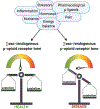From Pharmacology to Physiology: Endocrine Functions of μ-Opioid Receptor Networks
- PMID: 33676828
- PMCID: PMC8035298
- DOI: 10.1016/j.tem.2021.02.004
From Pharmacology to Physiology: Endocrine Functions of μ-Opioid Receptor Networks
Abstract
The steady rise in opioid users and abusers has uncovered multiple detrimental health consequences of perturbed opioid receptor signaling, thereby creating the need to better understand the biology of these systems. Among endogenous opioid networks, μ-receptors have received special attention due to their unprecedented biological complexity and broad implications in homeostatic functions. Here, we review the origin, molecular biology, and physiology of endogenous opioids with a special focus on μ-opioid receptor networks within the endocrine system. Moreover, we summarize the current evidence supporting an involvement of the latter in regulating distinct endocrine functions. Finally, we combine these insights to present an integrated perspective on μ-opioid receptor biology and provide an outlook on future studies and unresolved questions in this field.
Keywords: GPCR; evolution; hormones; opioids; oprm1; β-endorphin; μ-receptors.
Copyright © 2021 Elsevier Ltd. All rights reserved.
Conflict of interest statement
Declaration of Interests The authors have received honoraria, unrestricted educational grants, and research funding to the individual or the institution from Alexion (L.C.H.), Amgen (L.C.H., T.D.R.), Roche (T.D.R.), Shire (L.C.H., T.D.R.), and UCB (L.C.H., T.D.R.). Y.-X.P. is a co-scientific founder of Sparian Biosciences. The remaining authors have no potential conflicts of interest to declare.
Figures





References
-
- Fountas A et al. (2020) Opioid-induced endocrinopathies. Lancet Diabetes Endocrinol 8 (1), 68–80. - PubMed
-
- Porter J and Jick H (1980) Addiction rare in patients treated with narcotics. N Engl J Med 302 (2), 123. - PubMed
-
- Leung PTM et al. (2017) A 1980 Letter on the Risk of Opioid Addiction. N Engl J Med 376 (22), 2194–2195. - PubMed
Publication types
MeSH terms
Substances
Grants and funding
LinkOut - more resources
Full Text Sources
Other Literature Sources
Research Materials

